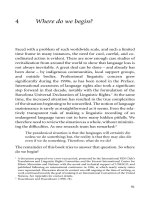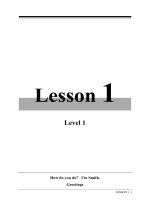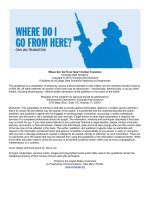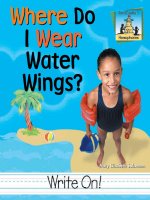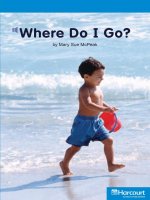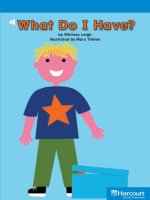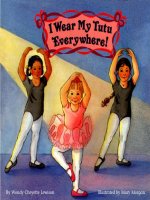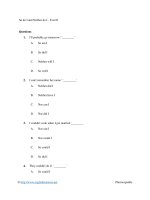where do i wear water wings
Bạn đang xem bản rút gọn của tài liệu. Xem và tải ngay bản đầy đủ của tài liệu tại đây (1.07 MB, 25 trang )
Salzmann
Where Do I
Wear Water Wings?
Salzmann
Where Do I Wear Water Wings?
A
B
D
O
Mary Elizabeth Salzmann
Mary Elizabeth Salzmann
Books in this series:
Can You Hear Me From Here?
Do We By, Buy, or Bye Tickets?
They’re There in Their Boat
Where Do I Wear Water Wings?
Who’s on Whose Spot?
You’re on Your Phone
Books in this series:
Can You Hear Me From Here?
Do We By, Buy, or Bye Tickets?
They’re There in Their Boat
Where Do I Wear Water Wings?
Who’s on Whose Spot?
You’re on Your Phone
Homophones are words that sound alike but are
spelled differently and have different meanings.
HOMOPHONES lvl3 10/24/01 7:16 PM Page 4
Mary Elizabeth Salzmann
Where Do I
Wear Water
Wings?
Where Do I
Wear Water
Wings?
Where/Wear guts FINAL 12/5/01 11:18 AM Page 1
Published by SandCastle™, an imprint of ABDO Publishing Company, 4940 Viking Drive, Edina,
Minnesota 55435.
Copyright © 2002 by Abdo Consulting Group, Inc. International copyrights reserved in all
countries. No part of this book may be reproduced in any form without written permission
from the publisher. SandCastle™ is a trademark and logo of ABDO Publishing Company.
Printed in the United States.
Cover and interior photo credits: Artville, Comstock, Corel, Diamar, Eyewire Images,
PhotoDisc
Library of Congress Cataloging-in-Publication Data
Salzmann, Mary Elizabeth, 1968-
Where do I wear water wings? / Mary Elizabeth Salzmann.
p. cm. (Homophones)
Includes index.
Summary: Photographs and simple text introduce homophones, words that sound alike
but are spelled differently and have different meanings.
ISBN 1-57765-799-3
1. English language Homonyms Juvenile literature. [1. English language Homonyms.]
I. Title. II. Series.
PE1595 .S28 2002
428.1 dc21
2001053307
The SandCastle concept, content, and reading method have
been reviewed and approved by a national advisory board
including literacy specialists, librarians, elementary school
teachers, early childhood education professionals, and parents.
Let Us Know
After reading the book, SandCastle would like you to tell us your
stories about reading. What is your favorite page? Was there something
hard that you needed help with? Share the ups and downs of learning
to read. We want to hear from you! To get posted on the ABDO
Publishing Company Web site, send us email at:
Where/Wear guts FINAL 12/5/01 11:18 AM Page 2
About SandCastle
™
Nonfiction books for the beginning reader
9 Basic concepts of phonics are incorporated with integrated language methods
of reading instruction. Most words are short, and phrases, letter sounds, and
word sounds are repeated.
9 Book levels are based on the ATOS
™
for Books formula. Other considerations
for readability include the number of words in each sentence, the number of
characters in each word, and word lists based on curriculum frameworks.
9 Full-color photography reinforces word meanings and concepts.
9 “Words I Can Read” list at the end of each book teaches basic elements of
grammar, helps the reader recognize the words in the text, and builds vocabulary.
9 Reading levels are indicated by the number of flags on the castle.
SandCastle uses the following definitions for this series:
9 Homographs: words that are spelled the same but sound different and have
different meanings. Easy memory tip: “-graph”= same look
9 Homonyms: words that are spelled and sound the same but have different
meanings. Easy memory tip: “-nym”= same name
9 Homophones: words that sound alike but are spelled differently and have
different meanings. Easy memory tip: “-phone”= sound alike
Level 1
(one flag)
Grades Pre-K to K
5 or fewer words per page
Level 2
(two flags)
Grades K to 1
5 to 10 words per page
Level 3
(three flags)
Grades 1 to 2
10 to 15 words per page
Look for more SandCastle books in these three reading levels:
Note: Some pages in this book contain more than 15 words
in order to more clearly convey the concept of the book.
Where/Wear guts FINAL 12/5/01 11:18 AM Page 3
Homophones
4
where wear
a word used to ask to be dressed
about the location in something
of something
Where/Wear guts FINAL 12/5/01 11:18 AM Page 4
Homophones are words that
sound alike but are spelled
differently and have different
meanings.
5
Homophones
Where/Wear guts FINAL 12/5/01 11:18 AM Page 5
Where do I find clothes to
dress up in?
I find them in the attic.
6
Homophones
Where/Wear guts FINAL 12/5/01 11:18 AM Page 6
This is my favorite cap.
I like to wear it backwards.
7
Homophones
Where/Wear guts FINAL 12/5/01 11:18 AM Page 7
Where do I go to fish?
I go fishing at the lake.
8
Homophones
Where/Wear guts FINAL 12/5/01 11:18 AM Page 8
Our dresses are alike.
We wear them for special
holidays.
9
Homophones
Where/Wear guts FINAL 12/5/01 11:18 AM Page 9
Where do we eat our snack?
We eat it in our tent.
10
Homophones
Where/Wear guts FINAL 12/5/01 11:18 AM Page 10
I wear my red and white
uniform when I play baseball.
11
Homophones
Where/Wear guts FINAL 12/5/01 11:18 AM Page 11
Where did we go on our trip?
We went to the ocean.
12
Homophones
Where/Wear guts FINAL 12/5/01 11:18 AM Page 12
I wear a special hat and jacket
when I ride my horse.
13
Homophones
Where/Wear guts FINAL 12/5/01 11:18 AM Page 13
Where do I play with my
yellow duck?
I play with it in the pool.
14
Homophones
Where/Wear guts FINAL 12/5/01 11:18 AM Page 14
I wear pink hair clips to match
my pink shirt.
15
Homophones
Where/Wear guts FINAL 12/5/01 11:18 AM Page 15
Where are we reading?
We are reading in the park.
16
Homophones
Where/Wear guts FINAL 12/5/01 11:18 AM Page 16
We wear life vests when we go
for a ride in our boat.
17
Homophones
Where/Wear guts FINAL 12/5/01 11:18 AM Page 17
Where am I playing with my
baby brother?
We are playing in the kitchen.
18
Homophones
Where/Wear guts FINAL 12/5/01 11:18 AM Page 18
We wear funny masks.
No one can see what we really
look like.
19
Homophones
Where/Wear guts FINAL 12/5/01 11:18 AM Page 19
Where do I make sand castles?
I make sand castles at the
beach.
20
Homophones
Where/Wear guts FINAL 12/5/01 11:18 AM Page 20
What do I wear on my hands
when I work in the garden?
(gloves)
21
Homophones
Where/Wear guts FINAL 12/5/01 11:18 AM Page 21
22
Words I Can Read
Nouns
A noun is a person, place, or thing
attic (AT-ik) p. 6
baseball (BAYSS-bawl)
p. 11
beach (BEECH) p. 20
boat (BOTE) p. 17
brother (BRUHTH-ur)
p. 18
cap (KAP) p. 7
clips (KLIPSS) p. 15
clothes (KLOHZ) p. 6
dresses (DRESS-ez)
p. 9
duck (DUHK) p. 14
garden (GARD-uhn)
p. 21
gloves (GLUHVZ) p. 21
hair (HAIR) p. 15
hands (HANDZ) p. 21
hat (HAT) p. 13
holidays
(HOL-uh-dayz) p. 9
homophones
(HOME-uh-fonez)
p. 5
horse (HORSS) p. 13
jacket (JAK-it) p. 13
kitchen (KICH-uhn)
p. 18
lake (LAKE) p. 8
life vests
(LIFE VESTSS) p. 17
location
(loh-KAY-shuhn) p. 4
masks (MASKSS) p. 19
meanings (MEE-ningz)
p. 5
ocean (OH-shuhn)
p. 12
park (PARK) p. 16
pool (POOL) p. 14
ride (RIDE) p. 17
sand castles
(SAND KASS-uhlz)
p. 20
shirt (SHURT) p. 15
snack (SNAK) p. 10
tent (TENT) p. 10
trip (TRIP) p. 12
uniform
(YOO-nuh-form) p. 11
word (WURD) p. 4
words (WURDZ) p. 5
Where/Wear guts FINAL 12/5/01 11:18 AM Page 22
23
Pronouns
A pronoun is a word that replaces a noun
Verbs
A verb is an action or being word
am (AM) p. 18
are (AR) pp. 5, 9, 16, 18
ask (ASK) p. 4
be (BEE) p. 4
can (KAN) p. 19
did (DID) p. 12
do (DOO)
pp. 6, 8, 10, 14, 20, 21
dress up (DRESS UHP)
p. 6
dressed (DRESSD) p. 4
eat (EET) p. 10
find (FINDE) p. 6
fish (FISH) p. 8
fishing (FISH-ing) p. 8
go (GOH) pp. 8, 12, 17
have (HAV) p. 5
is (IZ) p. 7
like (LIKE) p. 7
look (LUK) p. 19
make (MAKE) p. 20
match (MACH) p. 15
play (PLAY) pp. 11, 14
playing (PLAY-ing)
p. 18
reading (REED-ing)
p. 16
ride (RIDE) p. 13
see (SEE) p. 19
sound (SOUND) p. 5
spelled (SPELD) p. 5
used (YOOZD) p. 4
wear (WAIR) pp. 4, 7, 9,
11, 13, 15, 17, 19, 21
went (WENT) p. 12
work (WURK) p. 21
I (EYE) pp. 6, 7, 8, 11, 13,
14, 15, 18, 20, 21
it (IT) pp. 7, 10, 14
no one (NOH WUHN)
p. 19
something
(SUHM-thing) p. 4
them (THEM) pp. 6, 9
this (THISS) p. 7
we (WEE) pp. 9, 10, 12,
16, 17, 18, 19
what (WUHT) pp. 19, 21
Where/Wear guts FINAL 12/5/01 11:18 AM Page 23
24
Adjectives
An adjective describes something
Adverbs
An adverb tells how, when, or where something happens
backwards
(BAK-wurdz) p. 7
differently
(DIF-ur-uhnt-lee) p. 5
really (REE-lee) p. 19
where (WAIR) pp. 4, 6,
8, 10, 12, 14, 16, 18, 20
alike (uh-LIKE) pp. 5, 9
baby (BAY-bee) p. 18
different (DIF-ur-uhnt)
p. 5
favorite (FAY-vuh-rit)
p. 7
funny (FUH-nee) p. 19
my (MYE) pp. 7, 11, 13,
14, 15, 18, 21
our (OUR)
pp. 9, 10, 12, 17
pink (PINGK) p. 15
red (RED) p. 11
special (SPESH-uhl)
pp. 9, 13
white (WITE) p. 11
yellow (YEL-oh) p. 14
Where/Wear guts FINAL 12/5/01 11:19 AM Page 24

